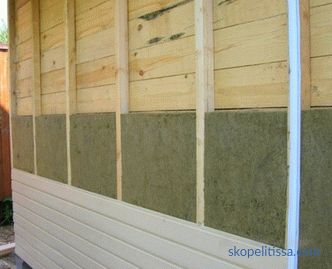For each owner of a country house, one of the priority tasks is the organization of an autonomous sewage system, which is a specific list of measures for the timely treatment and disposal of wastewater. One of the optimal solutions are septic tanks, in which the drains can move by gravity or drainage pump for sewage (the second name is “fecal”). The design of these devices allows pumping out not only liquid effluents, but also bottom sludge from the storage tank.
Drainage pumps differ from each other in power, throughput, body material and internal parts. The correct choice of the device depends on the general scheme of the septic tank, the expected frequency of its use and other factors that must be taken into account in order to obtain a reliable and efficient autonomous sewage system.
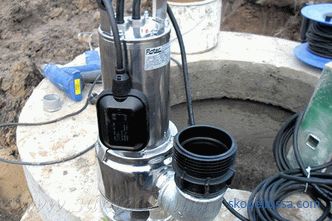
The fecal pump is primarily recognizable by the wide pipe, which must pass through not only the liquid effluent, but also the large fractions of waste
contained in themWhat is a drainage pump for sewage
A drainage pump for sewage is commonly understood as a special type of device designed for pumping wastewater containing dirt and other inclusions, which ensures the efficient functioning of the autonomous sewer system of a country house. Since some types of septic tanks allow you to make sewers truly autonomous, a properly selected drainage pump quickly pays for itself by saving on the call of the assenizator machine,
The principle of the drainage pump as a whole does not differ from any such device. As a result of the rotation of the working shaft, a rarefied space is formed in one of the pump compartments, into which the effluents from the receiving pipe enter. Then the liquid is pumped out from the first compartment, a zone of reduced pressure appears again and the cycle repeats.
Despite the general algorithm of work, there are a large number of very different modifications of drainage pumps, each of which is more suitable for specific tasks. To choose a suitable device, you should decide in advance on the conditions of subsequent operation, study the specifics of such equipment. For example, if foreign objects can get into the sewage system, then it is worth considering a pump with knives installed at the entrance - such a device will be clogged much less often.

This is how a fecal pump with a chopper works - knives cut foreign objects falling into the receiver and drains with crushed inclusions are already pumped further
Varieties Sewage Pumps
Sewage pumps are subject to a number of requirements. First of all, attention should be paid to the following characteristics:
-
low noise level;
-
quick and easy installation;
-
ease of use;
-
mobility is light weight and size;
-
sufficient engine power, therefore, height, which the pump is able to raise the pumped liquid;
-
body strength.
The ideal choice can be considered a device whose suitable technical characteristics are added to the listed requirements.
Case material
Sewage pumps are characterized by specific conditions of use - in the process of pumping wastewater, the equipment is exposed to a chemically aggressive, active environment. That is why the device should be sealed, made of chemically resistant materials. Such materials include:
-
cast iron;
-
stainless steel;
-
high-strength plastic.
The most optimal material for a casing of fecal pumps is stainless steel. This material has high strength, almost unlimited service life, resistance to aggressive environmental factors and chemical reagents.
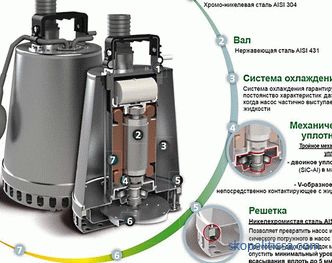
Sewage pump made of stainless steel - with a float and a chopper
However, a significant drawback of stainless steel devices is their high cost, compared with pumps from other materials. The average price segment is drainage pumps of standard construction made of cast iron. The most budget option - a pump in a plastic case.
Despite the tangible difference in cost, it is better not to use cheap models made of plastic or weak iron for pumping sewage water. Although this device is not always designed for daily use, it’s not worth pursuing a low price. Otherwise, the pump can quickly fail, and the savings will be sideways.
On our website you can find contacts of construction companies that offer the service of designing and installing sewage and water supply.Directly to communicate with representatives, you can visit the exhibition of houses "Low-rise Country".
Standard and special pumps for sewage
Now both domestic and foreign manufacturing companies produce pumps of two design varieties - for installation in a septic tank and household ones. General purpose equipment is a standard fecal pump for pumping wastewater. As for home appliances, they are designed to be installed under a kitchen sink or in a bathroom.
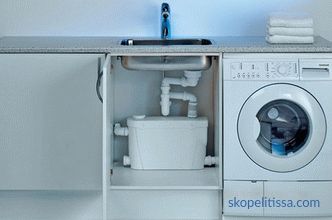
Household pumps are needed if for some reason one of the rooms is not possible to be connected to the public sewage system - the level for organizing the flow of money is not being observed or simply difficulties with installation
Such devices are characterized by low productivity and relatively short service life.
Installation method
Main types of faecal pumps, depending on the method of installation:
-
surface (installation is performed outside the well, only receiving hoses are immersed in the tank) ;
-
submersible (the whole device is immersed in the tank);
-
submersible (the pump is located in the well, and the engine is mounted on top).
Please note! Semisubmersible models are not equipped with shredders.
Place of use
-
Sewage pump in a private house, not equipped with a shredder. It is used in case of need pumping water without large inclusions, the temperature of which does not exceed 35-40 ° C. Most often used for pumping groundwater in basements during the autumn floods, it is also used for pumping the pool. Devices differ in the low cost, simplicity and wide range of use.
-
Pumps without choppers for pumping hot wastewater (used in saunas or baths). Can be used for pumping liquids with temperatures up to 90 degrees, which do not contain solid fractions.
-
Pumps with choppers for pumping hot effluent . Can be used for work with drains with a temperature up to 90 degrees - in saunas and baths, in the presence in them of a bathroom.
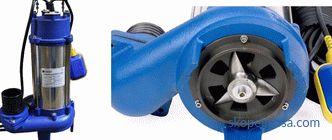
Centrifugal type pump in a cast-iron housing with a chopper
This can be interesting! In the article on the following link read about the drainage device.
-
Pumps with a grinder for pumping cold sewage. Universal devices that can work effectively both in sewage and drainage wells. In addition to the shredder, some models are equipped with an automatic reversing of the stroke - from time to time the pump pushes back part of the sucked fluid, “breaking” the sediment at the bottom of the septic tank.
The principle of operation of a sewage pump with a grinder is clearly shown in the following video:
How to choose sewer pump for a country house
If you are only going to buy a drainage pump, then first of all you need to decide on the operating conditions and only after that choose the appropriate model.
If a drainage sewage system is already present in the suburban area, then a compact pump with an automatic control system and small dimensions would be an excellent option for it. Give preference to stainless steel products. If the issue of saving is not in last place and you have to look in the direction of models with a plastic case, then at least watch out. To plastic was of high strength grades. In the case of a successful choice, you will get an inexpensive device with a low noise threshold and low weight.
As for the performance (power) of compact devices, it fluctuates around 3 l / s - this is quite enough for periodic pumping of wastewater.
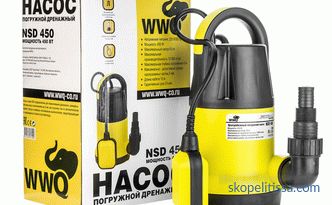
Pumps in plastic casing are no different from stainless steel models; Automation of work is provided by both built-in float and separately located sensors
It may be interesting! In the article on the following link read about rubble for drainage.
Steel drainage pumps for sewage in a private house, as compared with models made of cast iron and plastic, are distinguished by high efficiency of work and the possibility of use at a wide range of temperatures (up to 70 degrees).
The main field of application of these devices is the elimination of emergency situations on heating and hot water lines, in sewage systems for removing contaminants from dishwashers and washing machines.
Please note! If there is no chopper on the pump, this means that the device can work with liquids that do not contain large solid fractions (up to 10, sometimes up to 35 millimeters).To extend the life of such a pump, at the entrance it is necessary to install strainers of appropriate sizes and periodically inspect and clean them.
Installation of sewage in a private house: frequent mistakes and professional advice
The operation of the pump in the autonomous sewage of a country site involves only pumping waste from one particular tank to another, intended for final filtration and / or natural disposal Wastewater. In the case of a drainage system, water can be discharged into a special ditch. In any case, the well, in which the pump is installed, is located away from the house, closer to the border of the site and the sewage flows here by gravity (with a properly equipped septic tank).
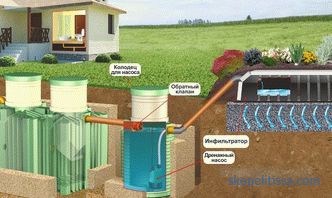
With a high level of groundwater, the effluent from the sump (distribution well) into the infiltrator (a device for final cleaning and disposal of waste into the soil) is fed by a drainage pump
The length of the drainage pipes must be at least 2 meters. Compliance with this rule ensures the flow of air into the drainage network, thus avoiding the occurrence of low pressure zones that may form after passing the flow of water.
Frequent mistakes when installing a sewage system:
-
Neglecting the use of shaped parts in places of bends of drainage pipes;
-
Not worth doing connections from sanitary equipment to the riser are very long - the distance from the bathroom to the riser should be up to 1 meter, from other devices to the riser the distance should not exceed 5 meters;
-
If you do not equip the riser ventilation, because of this, unpleasant smells can get into the room;
-
In the process of laying the external sewer system it is necessary take into account the slopes of the terrain - otherwise the passage of sewage becomes more difficult and increases the period of wear of the structure;
-
Disruption of the technology of connecting two sewer pipes together can lead to an emergency situation that is fraught with a breakthrough or periodic malfunctions of the sewer.
Visually about the selection of the drainage pump for a country house, see the following video:
It may be interesting! In the article on the following link read about drainage without rubble.
Conclusion
When creating an autonomous organization in a private house, special attention should be paid to the selection of high-quality equipment, in particular the drainage pump. It is necessary to approach the choice of the pump carefully, in advance having calculated the suitable power of the device, resistance to aggressive chemical environment. You should not save on the drainage pump for sewage, since the quality of its work depends on the functioning of the sewage system as a whole.
